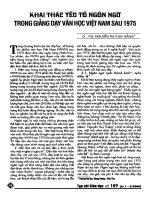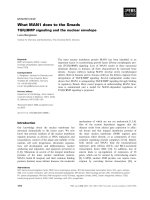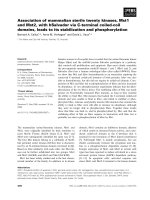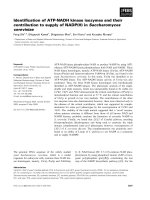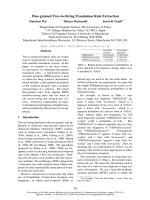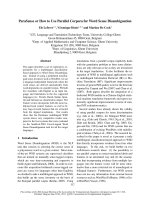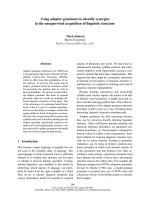Báo cáo khoa học: "State-of-the-art NLP Approaches to Coreference Resolution: Theory and Practical Recipes pot
Bạn đang xem bản rút gọn của tài liệu. Xem và tải ngay bản đầy đủ của tài liệu tại đây (114.27 KB, 1 trang )
Tutorial Abstracts of ACL-IJCNLP 2009, page 6,
Suntec, Singapore, 2 August 2009.
c
2009 ACL and AFNLP
State-of-the-art NLP Approaches to Coreference Resolution:
Theory and Practical Recipes
Simone Paolo Ponzetto
Seminar f
¨
ur Computerlinguistik
University of Heidelberg
Massimo Poesio
DISI
University of Trento
1 Introduction
The identification of different nominal phrases in
a discourse as used to refer to the same (discourse)
entity is essential for achieving robust natural lan-
guage understanding (NLU). The importance of
this task is directly amplified by the field of Natu-
ral Language Processing (NL P) currently moving
towards high-level linguistic tasks requiring NLU
capabilities such as e.g. recognizing textual entail-
ment. This tutorial aims at providing the NLP
community with a gentle introduction to the task
of coreference resolution from both a theoretical
and an application-oriented perspective. Its main
purposes are: (1) to introduce a general audience
of NLP researchers to the core ideas underlying
state-of-the-art computational models of corefer-
ence; (2) to provide that same audience with an
overview of NLP applications which can benefit
from coreference information.
2 Content Overview
1. Introduction to machine learning approaches
to coreference resolution. We start by focusing
on machine learning based approaches developed
in the seminal works from Soon et al. (2001) and
Ng & Cardie (2002). We then analyze the main
limitations of these approaches, i.e. their cluster-
ing of mentions from a local pairwise classifica-
tion of nominal phrases in text. We finally move
on to present more complex models which attempt
to model coreference as a global discourse phe-
nomenon (Yang et al., 2003; Luo et al., 2004;
Daum
´
e III & Marcu, 2005, inter alia).
2. Lexical and encyclopedic knowledge for
coreference resolution. Resolving anaphors to
their correct antecedents requires in many cases
lexical and encyclopedic knowledge. We accord-
ingly introduce approaches which attempt to in-
clude semantic information into the coreference
models from a variety of knowledge sources,
e.g. WordNet (Harabagiu et al., 2001), Wikipedia
(Ponzetto & Strube, 2006) and automatically har-
vested patterns (Poesio et al., 2002; Markert &
Nissim, 2005; Yang & Su, 2007).
3. Applications and future directions. We
present an overview of NLP applications which
have been shown to profit from coreference in-
formation, e.g. question answering and summa-
rization. We conclude with remarks on future
work directions. These include: a) bringing to-
gether approaches to coreference using semantic
information with global discourse modeling tech-
niques; b) exploring novel application scenarios
which could potentially benefit from coreference
resolution, e.g. relation extraction and extracting
events and event chains from text.
References
Daum
´
e III, H. & D. Marcu (2005). A large-scale exploration
of effective global features for a joint entity detection and
tracking model. In Proc. HLT-EMNLP ’05, pp. 97–104.
Harabagiu, S. M., R. C. Bunescu & S. J. Maiorano (2001).
Text and knowledge mining for coreference resolution. In
Proc. of NAACL-01, pp. 55–62.
Luo, X., A. Ittycheriah, H. Jing, N. Kambhatla & S. Roukos
(2004). A mention-synchronous coreference resolution al-
gorithm based on the Bell Tree. In Proc. of ACL-04, pp.
136–143.
Markert, K. & M. Nissim (2005). Comparing knowledge
sources for nominal anaphora resolution. Computational
Linguistics, 31(3):367–401.
Ng, V. & C. Cardie (2002). Improving machine learning ap-
proaches to coreference resolution. In Proc. of ACL-02,
pp. 104–111.
Poesio, M., T. Ishikawa, S. Schulte im Walde & R. Vieira
(2002). Acquiring lexical knowledge for anaphora resolu-
tion. In Proc. of LREC ’02, pp. 1220–1225.
Ponzetto, S. P. & M. Strube (2006). Exploiting semantic role
labeling, WordNet and Wikipedia for coreference resolu-
tion. In Proc. of HLT-NAACL-06, pp. 192–199.
Soon, W. M., H. T. Ng & D. C. Y. Lim (2001). A ma-
chine learning approach to coreference resolution of noun
phrases. Computational Linguistics, 27(4):521–544.
Yang, X. & J. Su (2007). Coreference resolution using se-
mantic relatedness information from automatically dis-
covered patterns. In Proc. of ACL-07, pp. 528–535.
Yang, X., G. Zhou, J. Su & C. L. Tan (2003). Coreference
resolution using competition learning approach. In Proc.
of ACL-03, pp. 176–183.
6

